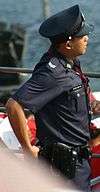Police Coast Guard
Coordinates: 1°15′24″N 103°49′59″E / 1.25667°N 103.83306°E
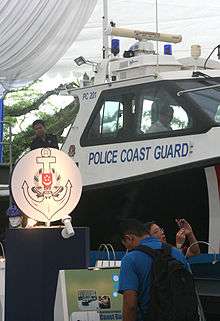
.jpg)
The Police Coast Guard (Abbreviation: PCG; Chinese: 警察海岸保卫处; Malay: Polis Pengawal Pantai) is the Marine Police division of the Singapore Police Force which also takes on roles of the coast guard typically handled by the military or as separate organisations in other countries. These include the enforcement of law and order in Singapore's territorial waters, and search and rescue operations in collaboration with the Maritime and Port Authority of Singapore, and the Immigration and Checkpoints Authority. Currently headquartered in Brani Regional Base at 11 Brani Way on Pulau Brani, Singapore, it traces a history of about 170 years.
History

Given Singapore's standing as a trading port since its founding in 1819, problems of piracy had accompanied its early maritime history until the 1840s when Temmenggong Daeng Ibrahim and his son, Sultan Abu Bakar of Johor, openly supported the British efforts to fight piracy. In 1866, the police's maritime operations were formally established with the building of a floating police station. Dedicated police patrol boats began patrolling the waters around the colony.
In 1916, the Marine Branch was set up, before being established as a separate unit in 1924 and renamed as the Marine Police. The new unit built its first headquarters near Cavenagh Bridge along the Singapore River, and had a fleet of about 26 boats and 238 officers. During the Japanese Occupation of Singapore, all vessels of the Marine Police were confiscated by the Japanese forces. After the war, the Marine Police saw rapid growth with the establishment of sub-bases at Tanjong Kling, Pulau Ubin and Pulau Tekong by 1951. In 1952, the fleet was boosted to 68 as a result of a reorganisation of the Police Force, and rose to 70 during the Konfrontasi with Indonesia in the 1960s in light of the increased operational needs.
With the attainment of independence for Singapore in 1965, the unit was upgraded in light of increased responsibilities for the new nation. It relocated its headquarters to the new Kallang Regional Base at Kallang Basin in 1970, and became known as the Marine Division.
The Marine Division underwent a major restructuring and was renamed as the Police Coast Guard on 13 February 1993, given its expanded roles in marine security responsibilities and capabilities, including preventing the intrusion of illegal migrants and foreign government vessels, and the guarding of the Horsburgh Lighthouse on the disputed island of Pedra Branca in the Singapore Straits. The PCG officiated the reorganisation of its operations into three squadrons, namely the Interceptor Squadron, the Port Squadron and the Coastal Patrol Squadron on 7 May 1993[1] and launched the Special Task Squadron (STS) on 22 January 1997.[2]
On 20 March 2006, it relocated its headquarters to its current location at Brani Regional Base, due to the planned damming of the Marina Bay and Kallang Basin. The new Police Coast Guard headquarters at Pulau Brani was officially opened on 8 February 2007 by the Minister for Home Affairs, DPM Wong Kan Seng.[3]
Incidents and accidents
- On 6 December 1984, police boat PX-5 left its base in Jurong for routine patrol. En route, SC Abdul Rashid Bin Mohammed Said shot SGT Chin Ah Kow in the head and threw his body overboard.[4] PC Wahid Bin Ahmad and PC Shamsudin Bin Haji Ali were forced off the boat, and subsequently found near Pulau Senang, by which time PC Wahid had drowned[5] and PC Shamsudin was the sole survivor. SGT Chin's body was never found.[6]
- On 28 December 1999, petrol bombs hurled from an escaping speedboat hit a police boat off Sembawang, although no one was hurt.[7] The speedboat was attempting to smuggle in illegal migrants, and was later captured by the police.[8]
- On 3 January 2003, six officers led by DSP1 Tan Wee Wah Stephen aboard PH50 (Hammerhead Shark) assisted in the rescue of crew on the stricken Republic of Singapore Navy ship RSS Courageous after a collision with a merchant ship, ANL Indonesia. All the officers were subsequently awarded with the Pingat Keberanian Polis.[9]
- On 11 September 2004, a collision between a PCG boat and a cabin cruiser out on a fishing trip resulted in the death of a 47-year-old Prisons officer. His partner and colleague was rescued.[10]
- In March 2006, a PCG craft PT34 rammed an outrigger canoe with six crew members from the Singapore Paddle Club, resulting in injuries to three canoe crew members.[10]
- On 13 April 2007, two Interceptor Craft of the Special Task Squadron were on ambush duty off Tuas in the vicinity of Tuas Jetty, when a speedboat with six illegal immigrants and cartons of cigarettes intruded into Singapore's territorial waters at about 9.30 PM. The speedboat sped off when approached by the police, resulting in a five-minute chase which ended with a collision between one of the craft and the speedboat near Pulau Merambong. PK 50 capsized, while the speedboat was completely wrecked. Two officers were rescued from the scene within minutes with minor injuries, while SI Mohd Khalid Bin Muhamad, 41, and SSGT Heah Khim Han, 29, who were trapped in the steering compartment, were missing.[11] Their bodies were found on 14 April 2007 at about 8.15 AM.[12] Three passengers on the intruding vessels were also rescued, and a fourth man was found dead. The rest of the passengers were still missing.[13] The two officers were the first casualties for the STS and the PCG since the latter's evolution from the Marine Division in 1993. It was also the first instance where a police boat capsized and the first police fatalities as a result of a high speed chase.[14] Both officers were posthumously promoted to the rank of Senior Station Inspector and Senior Staff Sergeant respectively.[15]
Organisation
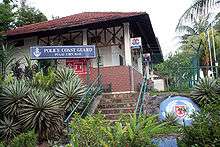
The Police Coast Guard is currently headed by Senior Assistant Commissioner HSU Sin Yun. It operates from four regional bases around the island, namely the Brani Regional Base in the south, Gul Regional Base in the west, Lim Chu Kang Regional Base in the north, and Loyang Regional Base in the east. It also maintains a police post on Pulau Ubin. Each of these regional bases are organised similarly to the Neighbourhood Police Centres of the land divisions, and conduct patrols within their respective maritime sectors.
The fleet is organised into three main squadrons.[1] The Interceptor Squadron consists of PC-class high-speed patrol craft able to control the movement of illegal immigrants along the Straits of Johor. The Port Squadron is made up of the newer generation PT-class boats (and previously the PX-class) with the primary task of ensuring the security of the Port of Singapore by responding to incidents and projecting police presence. The third squadron, the Coastal Patrol Squadron, operates the PH-class Coastal Patrol Craft to secure the sea passages in Singapore waters and ensure safe passage for legitimate users.
The PCG also has an elite unit known as the Special Task Squadron (STS), activated to conduct high-risk operations where speed and firepower are deemed necessary. They were instrumental in the capture of one of the three armed robbers who infiltrated into Singapore on Pulau Tekong in March 2004.
Operations

The Police Coast Guard conducts round-the-clock patrols in Singapore's territorial waters from its four regional bases, in an area of more than 200 square nautical miles (700 km²). It is also responsible for maintaining law and order on most of Singapore's islands, except those which are directly accessible by road from the main island, such as Jurong Island, Sentosa and Pulau Ubin.
While piracy was the main source of concern leading to the establishment of the Marine Police, it has become almost a non-issue today with no cases of piracy in Singapore's territorial waters in the last decade. Crimes in the offshore islands or in the waters are also markedly low.
Maritime border control
The control of illegal migrants entering Singapore's waters has become one of the most visible roles of the PCG, however, aided in part by constant media reports on such arrests. On 17 August 2006, its arrest of 22 illegal migrants in four separate incidents was touted as the largest number arrested by the PCG in a day by the media.[16] While the number of intrusions has been drastically reduced in recent years with the acquisition of radar and other sophisticated night-vision equipment, the attraction of Singapore as a migrant destination continues to pose a constant operational challenge to the PCG.
| Fiscal year | Illegal immigrants arrested | Source |
|---|---|---|
| 2002 | 49 | [17] |
| 2003 | 133 | [17] |
| 2004 | 171 | [18] |
| 2005 | 158 | [19] |
| 2006 | 234 | [20] |
| 2007 | 185 | [21] |
In a further bid to thwart illegal immigrants, the PCG erected physical barriers in the form of high fencing along critical areas of the shoreline where intrusions are common, including Lim Chu Kang, Pulau Punggol Barat, Pulau Ubin and the Western Live Firing Area. By the end of December 2003, the total length of fencing has reached 24.7 kilometres,[22] although there were some protests over the potential environmental hazards the fencing may pose to natural amphibious species, particularly on Pulau Ubin. The PCG attempted to allay these fears by informing that the fencing is constructed to allow small animals to pass below it.
Terrorism
The heightened security alert after the September 11, 2001 attacks necessitated additional attention paid to preventing possible terrorism attacks by sea, a possibility underscored during the revelation of the Singapore embassies attack plot by the Jemaah Islamiyah in December 2001, where it was revealed that the Changi Naval Base was the subject of surveillance.[23] There were also possible plans to bomb American navy ships using the narrow channel between Pulau Tekong and Changi in the northeast of Singapore.[24] In response to these threats, the PCG stepped up routine checks on vessels in Singapore's territorial waters, in particular on passenger ferries returning from regional destinations. Since late 2004, officers were given additional training in the areas of boarding vessels for this purpose, and equipped with skills in the detection of explosives, drugs and fraudulent documents.[25]
Coastal Security Force
The Police Coast Guard would be providing manpower to a new setup called the Coastal Security Force. The Coastal Security Force is a unit under the Maritime and Port Authority of Singapore that would be responsible for the safeguarding of non-gazetted landing points which falls under the International Ship and Port Facility Security Code or (ISPS).
Manpower
The Police Coast Guard has a strength of over 1,000, one of the largest amongst the operational units in the Singapore Police Force.[25] It has traditionally drawn its manpower from a common pool of officers as is the case with land divisions and most other line units. The majority were posted to the unit immediately after basic police training, while the rest were transferred from other divisions or units. In recent years, it offered an option for aspiring regular officers to apply directly to join the unit, thus needing only to attend common courses at the Home Team Academy before receiving specialised marine training for immediate posting within the unit upon graduation.
Due to the specialised nature of the job, officers with the PCG are less likely to transfer to other operational units. Senior Officers in the PCG are, however, usually posted there as part of their cyclical rotation amongst staff and line units after their mandatory initial posting as Investigation Officers, typically for a short stint of about two to five years. The unit's manpower is supplemented by national servicemen, as well as officers from the Volunteer Special Constabulary.
Uniforms
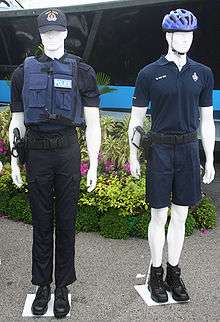
The evolution of uniforms worn by the Police Coast Guard largely mirrors that for the land-based divisions, with its earliest uniforms reflecting British heritage and influence. Early uniforms are based on that of navy sailors, consisting of an all-white attire of long-sleeved shirts and shorts. Officers wore the same khaki-based uniforms which were introduced in the land divisions from 1890, before switching to the Dacron blue uniform in 1969 along with the rest of the police force.
When the Marine Police was reorganised and renamed as the Police Coast Guard in 1993, the uniform was also changed to the Combat (or No. 4) Uniform. This uniform consisted of a long-sleeved shirt and long pants made of a slightly tougher polyester, and does away with almost all metal parts via the use of Velcro and plastic buttons. They don a blue beret, but are permitted to wear a baseball cap while on operational duties. Footwear is in the form of lace-up leather shoes with non-slip soles. Unlike the Combat Uniform worn by other units in the police force, the uniform adopted hidden plastic buttons to avoid entanglements, and does away with garters since shoes, and not boots, are worn to allow rapid removal should water entry be required.
In May 2005, the island Patrol Uniform was introduced, consisting of a helmet, dark blue polo top and Bermudas for officers performing bicycle patrol duties on Pulau Ubin.[26] These were introduced to project a softer image on the island where recreational activities abound, and to provide greater comfort for the officers in the humid outdoor weather.
As part of a force-wide review of the police uniforms, the PCG adopted the new combat uniform similar to that currently worn by the Special Operations Command, albeit with a darker shade of blue. While they were introduced to overcome existing limitations of the current uniform, such as allowing for less hindrance in body movement due to the more relaxed fit, and its non-flammable properties, they met with opposition from some officers who feel it projects the wrong image to the general public, including its "technician" look. Officers began to don the new combat uniform from 21 August 2006.
Firearms and equipment
Officers of the PCG are equipped with the Taurus Model 85 revolver, much like their land division counterparts. Though instead of the Monadnock PR-21 T-baton, PCG officers are issued with the ASP Telescopic Baton, due to its suitable and ease of use, especially when collapsed, in confined space on board ships. While the Glock 19 semi-automatic pistol is issued to Special Task Squadron officers. Police Coast Guard officers are also equipped with Sabre Red pepper spray as a less-than-lethal option.
Other weapons such as the Heckler & Koch MP5, M16 rifle and ARWEN 37 are also stowed aboard each patrol craft, with a pump action shotgun and the FN 303 as additional weapons for the Special Task Squadron. Mounted on the boats themselves are weapons such as the FN General Purpose Machine Gun, the Oerlikon 20 mm cannon and/or the Browning Machine Gun, depending on the type of craft.
Current fleet
There are currently eight types of boats utilised by the PCG, namely the Command Boat, the Coastal Patrol Craft (CPC), three types of PT boats, the new PC class Patrol Craft, the PK class Interceptor Craft for the Special Task Squadron, and the PJ Class inflatable boats for localised patrols, particularly up smaller rivers and canals.
Command Boat (PT Class)
The two Command Boats in operation are slightly larger versions of the regular Patrol Craft, and built by Asia-Pacific Geraldton in 1998.
| Ships |
|
| Length | 20 metres |
| Beam | 6.3 metres |
| Draft | 1 metre |
| Speed | 30 knots (60 km/h) |
| Weapons | 2x General Purpose Machine Guns |
New Coastal Patrol Craft
In 2006, the PCG signed a contract with Damen Shipyard to build 10 specially designed boats, the Damen StanPatrol 3507 to replace its aging Coastal Patrol Craft.[27] The first vessel PH51 Mako Shark was commissioned on 3 February 2009.[28]
| Ships |
|
| Displacement | 140 tonnes |
| Length | 35 metres |
| Beam | 7.16 metres |
| Draft | 1.66 metres |
| Speed | 35 knots (65 km/h) |
| Propulsion | 3 x MTU 16V4000 M71 diesels 2465 kW (3305 hp) @ 2000rpm, with 3 x HamiltonJet Model HM721 and MECS control, Reintjes VLJ 930 gearbox, 3 x Caterpillar C4.4 diesel |
| Sensor | Sperry Marine, STELOP COMPASS electro-optics |
| Weapons | 1× Mk 23 Rafael Typhoon weapon system/25mm Bushmaster chain gun[29] and 2× CIS 50 12.7 mm machine guns |
| Small Arms | Carbine, HK5 & Pistol. |
Patrol Craft (1st Generation, PT Class)
The oldest generation of Patrol Craft in PCG service (as of December 2012) were built in 1984. Odd numbered craft are based in Gul Base and even numbered craft are based in Brani. The first generation Patrol Craft are scheduled to be replaced by the 4th generation Patrol Craft from 2015 onwards. PT5 and PT11 were decommissioned and sold via auction on 29 October 2014.[30]
| Ships |
|
| Displacement | 20 tonnes |
| Length | 14.54 metres |
| Beam | 4.23 metres |
| Draft | 1.2 metres |
| Speed | 30 knots (60 km/h) |
| Weapons | General Purpose Machine Gun |
Patrol Craft (2nd Generation, PT Class)
The second generation of Patrol Craft were built between 1987 and 1989, including the two Command Boats. Another four boats are operated by the Immigration and Checkpoints Authority. Odd-numbered craft are based in Gul base.
| Ships |
|
| Length | 14.8 metres |
| Beam | 4.23 metres |
| Draft | 1.2 metres |
| Speed | 30 knots (60 km/h) |
| Weapons | General Purpose Machine Gun |
Patrol Craft (3rd Generation, PT Class)
The third generation of Patrol Craft were introduced in 1998, with 18 built in 1999 and another seven in 2000. They are the Stingray 18WJ Class[31] manufactured by Strategic Marine. At a top speed of 40 knots (74 km/h), they were 10 knots (19 km/h) faster than the older PT class boats in the PCG when they were officially launched on 29 January 2000[32] Odd-numbered craft are based in Gul Base.
| Ships |
|
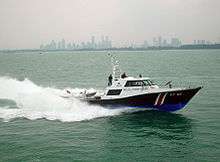 A third generation Patrol Craft, Flower Ray (PT65), conducting a sea-rescue demonstration |
| Length | 18 metres | |
| Beam | 5.4 metres | |
| Draft | 0.9 metres | |
| Speed | 40 knots (70 km/h) | |
| Weapons | 2X General Purpose Machine Gun |
Patrol Interdiction Boat (4th Generation, PT Class)
A new, 4th generation Patrol Interdiction Boat (PIB) sourced from Lung Teh shipyard, Taiwan is scheduled to enter service from 2015 onwards to progressively replace the 1st generation PT patrol craft.[33] The first vessel was commissioned on 21 July 2015.[34] A total of 11 boats would be acquired.
| Ships |
|
| Length | 18 ~ 19 metres |
| Beam | ? |
| Draft | ? |
| Speed | More than 45 knots (80 km/h) |
| Weapons | 1X General Purpose Machine Gun |
New Generation Patrol Craft (PC Class)
The New Generation Patrol Craft, also known as the Fast Response Craft, were delivered from the year 2002. There are currently 32 in active service. Even-numbered craft are based in Loyang Base, while odd-numbered craft are in Lim Chu Kang.
| Ships |
|
| Length | 11.5 metres |
| Beam | 3.4 metres |
| Draft | 0.5 metres |
| Speed | 40 knots (70 km/h) |
Interceptor Craft (PK Class)
There are two generations of Interceptor Craft in service, with the first delivered in 1995 by North shipyard. The second generation of six boats with a different colour scheme and modified design was introduced in 1999[35] and officially launched on 29 January 2000.[32] The second generation interceptor craft were not considered a success and was relegated to normal patrol duties and renamed into the PC class. A single vessel, PK/PC 23 was rebadged and operates as a Marine Command Vessel (MCV) under the Singapore Civil Defence Force's Marine Command.
| Ships |
|
 An Interceptor Craft, Spikefish (PK50), from the Special Task Squadron demonstrating its capabilities during a maritime exercise mockup display as part of the National Day Parade, 2005 celebrations |
| Length | 12 metres | |
| Beam | 3.6 metres | |
| Draft | 0.8 metres | |
| Speed | 50 knots (90 km/h) | |
| Weapons | General Purpose Machine Gun |
Interceptor Craft (2nd generation PK Class)
A new, 2nd generation PK interceptor was ordered from Lung Teh shipyard, Taiwan in May 2014 and is scheduled to enter service from 2015 onwards. The two vessels (Black and White Marlin) were commissioned on 21 July 2015.[34]
| Ships |
|
|
| Length | 14 metres | |
| Beam | 2.7 metres | |
| Draft | 1.5 metres | |
| Speed | 55 knots (100 km/h) | |
| Engine | 2 MAN D2876LE diesels; 1,460 hp (1.07 MW) ; 2 shafts |
Rigid-hulled Inflatable Boats ( PJ Class)
The PJ Class of rigid-hulled inflatable boats is suitable for cruising upriver and large drains and introduced in 1997.
| Ships |
|
| Length | 6.0 metres |
| Beam | 2.5 metres |
| Draft | 0.8 metres |
| Speed | 40 knots (70 km/h) |
Other
There are several other types of fast craft boats playing a supportive role. The following is a list of 2nd generation PK class vessels. They have been renumbered and are put into normal patrol operations.
| Ships |
|
Decommissioned vessels
Coastal Patrol Craft (PH Class)
The PCG operated a fleet of 12 former Republic of Singapore Navy Coastal Patrol Craft (CPC). The craft were upgraded and handed over by the Republic of Singapore Navy (RSN),[36] with the first four officially handed over on 7 May 1993[1] another four on 3 June 1994,[37] and the last four on 22 January 1997 as part of the formation of the Police Coast Guard Coastal Patrol Squadron.[2] The CPCs were built between 1979 and 1980, but continued service for over two decades while a proper replacement was being sourced. Five of the decommissioned vessels were transferred to the Indonesian Marine Police (POLAIR) on 9 February 2012.[38]
| Ships |
|
| Displacement | 45.7 tonnes |
| Length | 22.7 metres |
| Beam | 6.2 metres |
| Draft | 1.6 metres |
| Speed | 20 knots (37 km/h) |
| Weapons | Oerlikon 20 mm cannon, 2 x 0.5" Browning Machine Gun |
| Small Arms | Carbine, HK5 & Pistol. |
Collaborations
The PCG has engaged in joint operations with the Republic of Singapore Navy (RSN) since the 1990s,[39] as well as with foreign agencies. Alliances were forged with the Royal Malaysian Police Marine Operations Force and the TNI-AL (Indonesian Navy). It is involved in the annual Cooperation Afloat Readiness and Training (CARAT) programme with the United States Coast Guard, the RSN, and five other Southeast Asian countries.[40] In 2001, it was involved in a joint anti-illegal migrant operation with the Japan Coast Guard in Kanazawa.[41] The PCG also has collaborations with the Republic of Korea Coast Guard[42] and makes regular contacts with the Hong Kong Police Force's Marine Region through a reciprocal attachment programme.[43]
The PCG has collaborated with the National Police Cadet Corps to establish sea units in secondary schools. The first two units were set up in Anglo-Chinese School (Independent) and Springfield Secondary School in 2002, with the PCG's pool of reservists and Volunteer Special Constabulary officers providing training for the cadets.[44] The first all-girls sea unit was set up in Raffles Girls' School (Secondary) in 2006. The PCG also supports the Special Tactics and Rescue Unit’s maritime assault capability, which was launched on 2 February 2005.[45]
References
General
- "Policing Singapore in the 19th & 20th centuries", Peer M. Akbur, Singapore Police Force, 2002 ISBN 981-04-7024-X
- English News - Five more illegals caught at sea trying to enter Singapore, Justyn Olby, Television Corporation of Singapore, 17 March 1998
- English News - Coast Guard steps up fight against illegal immigrants, Justyn Olby, Television Corporation of Singapore, 18 February 1998
Specific
- 1 2 3 Police Coast Guard (7 May 1993). "Speech by Prof S Jayakumar, Minister for Law and Home Affairs, at the Formation Ceremony of the Police Coast Guard Patrol Squadrons and Naming of Coastal Patrol Craft on Friday, 7 May 93 at 11.00 AM at the Police Coast Guard Headquarters, Stadium Lane" (PDF).
- 1 2 Police Coast Guard (22 January 1997). "Speech by Mr Wong Kan Seng, Minister for Home Affairs, at the Combined Ceremony for the Formation of the Pcg Special Task Squadron and the Naming of Coastal Patrol Craft on 22 Jan 97 at 10.00 Am at PCG Headquarters".
- ↑ Farah Abdul Rahim (8 February 2007). "220 illegal immigrants arrested in 2006, up from 158 in 2005". Channel NewsAsia.
- ↑ "Sergeant feared dead and PC drowned in gun drama on boat". The Straits Times. 7 December 1984.
- ↑ "Obituary". Police Life. Singapore Police Force. 10 (6): 5. January 1985.
- ↑ "Boat murder suspect held in flat raid". The Straits Times. 9 December 1984.
- ↑ "Petrol bombs hit police boat". The Straits Times. 28 December 1999.
- ↑ "Petrol-bomb attack on cops: Two nabbed". The Straits Times. 7 January 2000.
- ↑ "News Release Police Medal of Valour for Rescue Efforts of RSS Courageous". Ministry of Home Affairs. 8 October 2003.
- 1 2 "Other patrol boat collisions". The Straits Times. 15 April 2007.
- ↑ Julia Ng (14 April 2007). "2 Police Coast Guard officers killed in sea collision". Channel NewsAsia.
- ↑ "Two PCG Crewmen Killed in the Line of Duty" (Press release). Singapore Police Force. 14 April 2007. Retrieved 2007-04-14.
- ↑ Julia Ng (14 April 2007). "2 Police Coast Guard officers killed in sea collision (updated)". Channel NewsAsia.
- ↑ "Officer buried with honours". The Straits Times. 15 April 2007.
- ↑ "2 coast guard officers die after sea chase". The Straits Times. 15 April 2007.
- ↑ Joanne Leow (18 August 2006). "22 immigration offenders nabbed in four separate incidents". Channel NewsAsia.
- 1 2 "Singapore Police Force Annual 2004". Singapore Police Force. Archived from the original on 2007-07-14. Retrieved 2007-11-04.
- ↑ "Singapore Police Force Annual 2005". Singapore Police Force. Archived from the original on 2007-07-14. Retrieved 2007-11-04.
- ↑ "Singapore Police Force Annual 2006". Singapore Police Force. Archived from the original on 2007-10-28. Retrieved 2007-11-04.
- ↑ "Singapore Police Force Annual 2007". Singapore Police Force. Retrieved 2008-08-09.
- ↑ "Singapore Police Force Annual 2008". Singapore Police Force. Retrieved 2009-03-15.
- ↑ "Singapore Police Force Annual 2004". Singapore Police Force. 2005.
- ↑ "Singapore reveals more proof of terrorist plot". Asian Political News. 4 March 2002.
- ↑ Jeremy Zakis, and Steve Macko (12 January 2002). "Major Terrorist Plot in Singapore Discovered; al-Qaeda Believed Well Established in the Asian Region". EmergencyNet News.
- 1 2 "Singapore Police Force Annual 2005 - Police Coast Guard". Singapore Police Force. 2006.
- ↑ "New Police Coast Guard regional base in Loyang enhances facilities". Channel NewsAsia. 30 May 2005.
- ↑ Valarie Tan (17 July 2006). "Police Coast Guard to get 10 new patrol vessels over next two years". Channel NewsAsia.
- ↑ "Damen Shipyards Singapore delivers it's (sic) 100th vessel!". Damen Shipyard. 3 February 2009.
- ↑ Muhammad Juffry, Bin Joihani (Jul–Aug 2009). "PCG upgrades with new fleet and training centre". Police Life Monthly. Singapore: Singapore Police Force. 35 (7). ISSN 0217-8699. Retrieved 8 November 2010.
- ↑ http://www.knightfrank.com.sg/resources/pdfs/catalogues-for-public-29-oct-2014.pdf
- ↑ http://www.strategicmarine.com/brochures/Stingray18WJ.pdf
- 1 2 Police Coast Guard (29 January 2000). "Speech by Mr Wong Kan Seng, Minister for Home Affairs, at the Launch of Police Coast Guard's New Patrol and Interceptor Boats on Saturday 29 January 2000, 10.05 AM, at Police Coast Guard Headquarters, 5 Stadium Lane.".
- ↑ http://www.singaporebudget.gov.sg/data/budget_2015/download/37%20MHA%202015.pdf
- 1 2 Loke, Kok Fai (2015-07-21). "New Police boats to better intercept illegal immigrants, terrorists and smugglers". Channelnewsasia. Singapore. Retrieved 2015-07-21.
- ↑ "Full steam ahead for Coast Guard". The Straits Times. 30 January 2000.
- ↑ "Speech by RADM (NS) Teo Chee Hean, the Minister for Education and Second Minister for Defence, at the Launching of RSS Independence". Government of Singapore. 2006. Archived from the original on October 26, 2007. Retrieved 2007-11-01.
- ↑ Police Coast Guard (3 June 1994). "Speech by Mr Wong Nan Seng, Minister for Home Affairs, at the Naming Ceremony for the Second Batch of Coastal Patrol Craft at Police Coast Guard Headquarters, Stadium Link on Monday, 25 April 1994 at 10.00 AM" (PDF).
- ↑ "Police Coast Guard presents five coastal patrol craft to the Indonesian Marine Police". Ministry of Home Affairs. 2012. Retrieved 2015-03-03.
- ↑ Police Coast Guard/Republic of Singapore Navy (27 September 2000). "Ministry of Defence, Ministry of Home Affairs and Singapore Police Force Joint News Release, 27 Sep 2000: Ministerial Visit to the Police Coast Guard and the Republic Of Singapore Navy".
- ↑ Sue A. Lackey (August 2005). "Hidden Jewel". Navy League of the United States. Archived from the original on 2005-10-24.
- ↑ "Police, coast guard hold drill to stop illegal immigrants". Asian Political News. 2001-05-21. Retrieved 2007-11-01.
- ↑ "Singapore, Korea coast guards to combat transnational crime". Channel NewsAsia. 2007-07-31. Retrieved 2007-08-01.
- ↑ http://www.police.gov.hk/offbeat/844/eng/n08.htm
- ↑ "NPCC Sea Units Background". National Police Cadet Corps. 9 October 2007.
- ↑ Police Coast Guard/Special Operations Command (2 February 2005). "Speech By A/P Ho Peng Kee, Senior Minister of State for Law and Home Affairs, at Commissioning Ceremony of the STAR Unit Maritime Assault Capability, 2 February 2005, 10.00 AM at Police Coast Guard, Pulau Brani Base".
External links
| Wikimedia Commons has media related to Police Coast Guard. |
